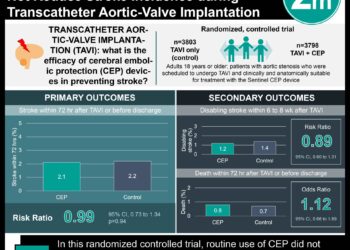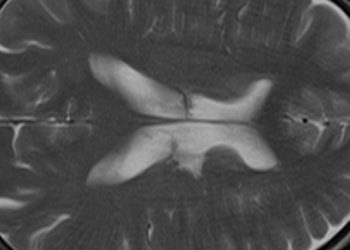Factors associated with poor clinical outcomes of STEMI after door-to-balloon time target achieved
1. Low BMI, Killip class 3/4, history of previous MI, use of mechanical support, and flow worsening were shown to be significantly associated with major adverse cardiac events (MACE) in patients with an ST-elevation myocardial infarction (STEMI) who have achieved a door-to-balloon time (DTBT) under 90 minutes.
2. Radial access appeared to have a significant inverse association with MACE.
3. Flow worsening during percutaneous coronary intervention (PCI), as a modifiable factor, may be important to avoid, even DTBT is achieved.
Evidence Rating Level: 2 (Good)
Study Rundown: The advent of primary percutaneous coronary interventions (PCIs) has reduced both morbidity and mortality in patients with ST-elevation myocardial infarctions (STEMIs). Recent clinical guidelines target <90 minutes for door-to-balloon-time (DTBT) in PCIs to minimize the poor clinical outcomes significantly associated with longer DTBTs. This retrospective cohort study, using hospital records from the Saitama Medical Centre, examined other factors which may also worsen clinical outcomes in patients undergoing primary PCI. They found low body mass index, history of previous myocardial infarction, Killip class 3 or 4, flow worsening during PCI, and use of mechanical support were significantly associated with major adverse cardiac events (MACE), which includes all-cause death, acue myocardial infarction, and acute heart failure requiring hospitalization. Meanwhile, radial approach showed an inverse association with MACE. This study supports avoiding flow worsening in primary PCI, even when appropriate DTBT is achieved. However, this variable was judged retrospectively and mild flow worsening and its effects may not have been captured. Also, given the study design, some of the identified factors, such as the use of mechanical support, may be associated with poor clinical outcomes not because they were the cause of the clinical outcomes, but as an effect of poor clinical status. Similarly, femoral access tended to be selected over radial access at this site for patients with more complex requirements, like hemodialysis, or in more severe status, such as shock or pulmonary arrest. Thus, this study could not control for all confounding factors and as a single-centre observational study, may have some institutional and patient selection bias that decreases the generalizability of their results. Further investigation is needed into the factors identified by this study before considering additional therapeutic targets to DTBT in PCIs. Nonetheless, this study provides further insight into factors that may correlate with clinical outcomes for patients presenting with STEMI.
Click to read the study in PLOS ONE
In-Depth [Retrospective observational study]: This study included 383 patients (mean age 67.5 yo, 19.3% female, 7.9% previous MI, 9.7% previous PCI, 16.8% triple vessel disease) taken from 1293 patients diagnosed with acute MI admitted to the Sitama Medical Center in Japan from January 2015 to August 2019. Patients experienced cardiac arrests outside of the hospital at a prevalence rate of 6.5%, and 12.0% of patients required mechanical supports. Patients with unclear door times, often nosocomial cases, NSTEMIs, delayed admission over 24 hours, or who did not undergo primary PCI or did not achieve DTBT <90 min were excluded. Mean DTBT was 60.3+15.7 minutes and onset to balloon time was 322+327 minutes. The median followup was 281 days (IQR: 188-616 days). The primary endpoint of major adverse cardiac events (MACE) showed an incidence rate of 16.2% (all cause death 8.6%, AMI, 4.7%, acute heart failure requiring hospitalization 4.2%). Both a univariate and multivariate Cox hazard analysis were performed on patient characteristics. The multivariate analysis showed both low BMI (<20kg/m2) (HR: 3.14 95% CI 1.53-6.46), history of previous MI (HR: 2.39, 95% CI 1.06-5.37), and Killip class 3 or 4, compared to Killip class 1 or 2 (HR 2.10, 95% CI 1.10-3.99) were significantly associated with MACE. A univariate analysis and two multivariate models were performed on angiographic/procedure characteristics, with one including flow worsening and one without, and a final multivariate Cox hazard model included clinical, angiographic, and procedural factors significantly associated with MACE. Flow worsening was shown to be significantly associated with MACE (HR 3.24, 95% CI 1.79-5.86) in the first multivariate analysis, and in the second model that included flow worsening, radial approach, inversely so (HR 0.54, 95% CI 0.32-0.92), and use of mechanical supports (HR 3.15, 95% CI 1.71-5.79) continued to be significantly associated with MACE. However, in the multivariate model which included final TIMI grade <2, TIMI grade < was not found to be associated with MACE. Ultimately, future study on these associated variables would be worthwhile to predict which STEMI patients who, despite achieving a DTBT <90 minutes, would more likely have poor clinical outcomes. Of most interest, flow worsening is a modifiable factor which we may see benefit from avoiding in primary PCI.
Image: PD
©2020 2 Minute Medicine, Inc. All rights reserved. No works may be reproduced without expressed written consent from 2 Minute Medicine, Inc. Inquire about licensing here. No article should be construed as medical advice and is not intended as such by the authors or by 2 Minute Medicine, Inc.







